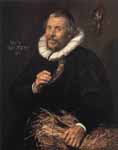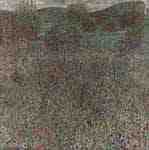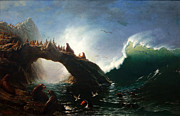Carnegie Museum of Art

Farallon Island, Albert Bierstadt

Pieter Cornelisz van der Morsch, Frans Hals

Blossoming field, Gustav Klimt

Young Woman under the Apple Tree, Edvard Munch
Fine Art Prints | Greeting Cards | Phone Cases | Lifestyle | Face Masks | Men's , Women' Apparel | Home Decor | jigsaw puzzles | Notebooks | Tapestries | ...
The Carnegie Museum of Art, located in the Oakland neighborhood of Pittsburgh, Pennsylvania, is an art museum founded in 1895 by the Pittsburgh-based industrialist Andrew Carnegie.[1] The museum holds a distinguished collection of contemporary art, including film and video works.
History
The museum's origins can be traced to 1886 with Andrew Carnegie's initial concept:[2] "I am thinking of incorporating with the plan for a library that of an art-gallery in which shall be preserved a record of the progress and development of pictorial art in America." Dedicated on November 5, 1895, the art gallery was initially housed in the Carnegie Libraries of Pittsburgh Main Branch in Oakland.
Carnegie envisioned a museum collection consisting of the "Old Masters of tomorrow" and the Carnegie Museum of Art became, arguably, the first museum of modern art in the United States. The museum received a major expansion in 1907 with the addition of the Hall of Architecture, Hall of Sculpture, and Bruce Galleries, with funds again provided by Carnegie.[3]
Under the directorship of Leon Arkus, the Sarah Mellon Scaife Gallery (125,000 square feet) was built as an addition to the existing Carnegie Institute. Designed by architect Edward Larrabee Barnes, it first opened in 1974 and more than doubled the museum's exhibition space, plus added a children's studio, theater, offices, café, and bookstore.[4] The New York Times art critic John Russell described the gallery as an "unflawed paradise." The gallery has been renovated several times since its original creation, most recently in 2004.
Today the museum continues Carnegie's love of contemporary art by staging the Carnegie International every few years. Numerous significant works from the Internationals have been acquired for museum's permanent collection including Winslow Homer's The Wreck (1896) and James A. McNeill Whistler's Arrangement in Black: Portrait of Señor Pablo de Sarasate (1884).
Collections and departments
Neapolitan Presepio seasonally displayed at the Carnegie Museum of Art
The museum's curatorial departments include: Fine Arts (Contemporary Art, Works on Paper), Decorative Arts, Architecture, and Photography. The museum presents as many as 15 changing exhibitions annually. Its permanent collection comprises roughly 35,000 works and includes European and American decorative arts from the late seventeenth century to the present, works on paper, paintings, prints (notably Japanese prints), sculptures and installations. The museum has notably strong collections of both aluminum artifacts and chairs. Approximately 1,800 works are on view at any given time.
In 2001, the museum acquired the archive of African-American photographer Charles "Teenie" Harris, consisting of approximately 80,000 photographic negatives spanning from the 1930s to the 1970s. The museum is working with a Teenie Harris Advisory Committee identify the photographs. Many of these images have been catalogued and digitized and are available online via the Carnegie Museum of Art Collections Search.
Heinz Architectural Center: Established in 1990 with a gift from Mrs. Henry J. Heinz II, the Heinz Architectural Center enhances appreciation and understanding of architecture and the built environment through exhibitions, lectures, charettes, symposia, and other forms of public engagement. Its collection of nearly 6,000 objects includes drawings, models, photographs, artifacts, games, ephemera, and the world’s third-largest collection of plaster architectural casts. Ranging from the late 18th century to the present, the collection represents work in architecture, landscape design, engineering, and furniture and interior design by architects of international, national, and regional significance. Areas of strength are residential architecture and leading contemporary British architects; recent collecting activity has focused on the work of emerging practices around the world. In addition to 4,000 square feet of exhibition space, the Heinz Architectural Center’s facility, designed by Cicognani Kalla Architects, includes a library housing several thousand books, journals, and other types of printed material.
The Hillman Photography Initiative is an incubator for innovative thinking on the photographic image. The inaugural year of the initiative centered around four projects that, taken together, investigated the boundaries and possibilities of photography through the way that an image travels. Conceived through an open, discursive process, unique in a museum setting, these projects included live public events at the museum, a pop-up reading room in the galleries, two collaborative web-based projects, and a series of commissions, including documentary videos, art projects, and writing.
Galleries
Cast of the north transept portal of the Bordeaux Cathedral in the Hall of Architecture
Ailsa Mellon Bruce Galleries (1907) - originally constructed display reproduction bronze casts from Pompeii and Herculaneum. Renovated in 2009, the galleries exhibit more than 500 objects representing American and European decorative arts from the Rococo and Neoclassical periods of the 18th century to contemporary design and craft.
Hall of Architecture (1907) - In the late Victorian era, plaster casts of outstanding classical, ancient, and medieval works were mass-produced by various vendors. Just a few museums, like Carnegie Museum of Art, went to extraordinary lengths to develop their own large, unique casts. The West Portal of Saint-Gilles-du-Gard, paid for by Andrew Carnegie on the recommendation of art experts, is one of a kind, and is arguably the largest architectural cast ever made. Today the Hall of Architecture houses almost 140 full-size plaster casts of elements of buildings found in the ancient and classical civilizations of Egypt, Greece, and Rome, and from Romanesque, Gothic, and Renaissance Europe. As such, it is the largest collection of plaster casts of architectural masterpieces in America and one of the three largest in the world, along with those of the Victoria and Albert Museum in London and the Musée national des Monuments Français in Paris.
Hall of Sculpture (1907) - modeled upon the Parthenon's inner sanctuary, and originally created to house the museum's 69 plaster casts of Egyptian, Near Eastern, Greek, and Roman sculpture. Today it exhibits works from the permanent collections, with its balcony displaying decorative arts objects from the eighteenth to the twentieth century.
Heinz Architectural Center (1993) - dedicated to the collection, study, and exhibition of architectural drawings and models.
Scaife Galleries - Focused primarily on European and American art since 1850, but also including collections of African art, classical and Egyptian art, and older European and American art.
Works on Paper Gallery
Forum Gallery
Programs
Over the past 75 years, more than 100,000 children of all ages have attended Saturday art classes in the galleries of Carnegie Museum of Art. Alumni of the program include Andy Warhol, photographer Duane Michals, and contemporary artist Philip Pearlstein. The museum has an array of programs that are specific to one's age group as well. There are some for children, teens, adults, and there are even some dedicated to school educators.[5] The Carnegie Museum of Art was named 5th most child-friendly art museum in the U.S. by Child magazine.
See also
Portal icon Pittsburgh portal
Andrew Carnegie
Carnegie Museums of Pittsburgh
List of museums in Pennsylvania
References
About Carnegie Museum of Art: History
W. J. Holland, LL.D., "The Carnegie Museum", in Popular Science, May 1901.
Memorial of the celebration of the Carnegie Institute at Pittsburgh, Pa., April 11, 12, 13, 1907.
Ellen S. Wilson, "The Continuing History of the Scaife Galleries", in Carnegie Online, July/August 2003 [1].
"School of Rock, Art, and Science". Carnegie Museums of Pittsburgh.
----
Fine Art Prints | Greeting Cards | Phone Cases | Lifestyle | Face Masks | Men's , Women' Apparel | Home Decor | jigsaw puzzles | Notebooks | Tapestries | ...
----
Artist
A - B - C - D - E - F - G - H - I - J - K - L - M -
N - O - P - Q - R - S - T - U - V - W - X - Y - Z
Retrieved from "http://en.wikipedia.org/"
All text is available under the terms of the GNU Free Documentation License



